
In my previous article on New Manila, I wrote of the history of the place, as well as of the many landmarks of this historical part of Quezon City. What I didn’t tackle were the stories of the old mansions in the area, and the families who lived in them. Some are still standing, but are in a state of disrepair. Other homes have been bulldozed to make way for the modern architectural tastes of the new residents.
The New Manila district was first developed in the 1930s, by Doña Magdalena Hashim Ysmael-Hemady (1877-1955), who had purchased the former Jesuit friar lands of San Juan Del Monte from the America colonial government of the Philippines (1898-1946). Doña Magdalena was a Lebanese, whose maiden name was Wadi’ah Hashim (or Wadiyah), before changing her name when she converted to Catholicism, when she settled in the Philippines. Doña Magdalena came to the Philippines with her husband, Juan Ysmael Sr. (1864-1908), whose Lebanese name was originally Hanna Mansour Gemayel, but had to change it to Ysmael, due to the difficulty of Filipinos and American in pronouncing his name. Hailing from the Bikfaya region of Lebanon, the Ysmaels took as ship to Australian around 1905, to escape the persecution and force military drafts of the Turkish Ottoman Empire, which had controlled the country. While on route to Australia, their ship had to make an emergency stop in Davao, due to engine trouble. The Ysmaels and many other Lebanese families disembarked and fell in love with the country. Soon the Ysmaels moved to Manila, and established a steel manufacturing plant along España Boulevard Extension.
Doña Magdalena would join her brother Faride T. Hashim Sr. (1841-1931), who had migrated earlier to the Philippines, and establish the Manila Grand Opera House, which allowed Doña Magdalena’s family to hobnob with Manila’s wealthy and powerful, and build more business and political connections.
Years after Juan’s death, Doña Magdalena would remarry to another Lebanese migrant, Kemal “Dodo” H. Hemady (1884-1952), who would help her establish the Magdalena Estates, which is now called New Manila. Doña Magdalena never had children with Kemal, and she raised her three children from Juan: Felipe, Magdalena/Mariana, and Juan Jr. They would continue the businesses of their mother, and would intermarry with other notable local families, such as the Recto and Perez-Rubio clans, further cementing their continuing influence in Filipino society.
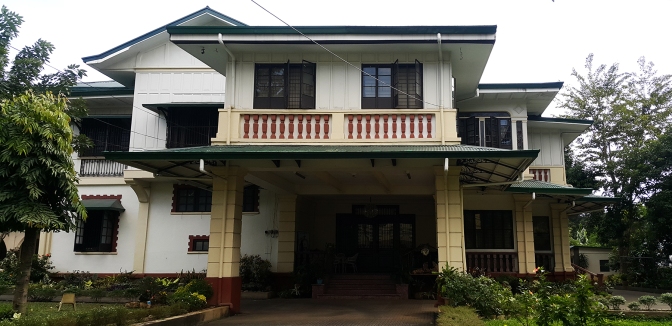
Doña Magdalena and Kemal would build their home on 20 Broadway Avenue, on a hilltop estate overlooking the lot that would be the site of the Our Lady of Mount Carmel Parish, and see the construction of the church, but never witness its completion. Years after Doña Magdalena’s passing, her family opened the home to be the new Provincial House of the Pastorelle Sisters. The Pastorelle Sisters, or Suore Jesu Buen Pastor (SJBP, or Sisters of Jesus the Good Shepherd), was founded in 1938 by Giacomo Allocco Alberione (1884-1971), in Rome; and their primary roles was to support schools and parishes by providing religious instruction. In 1965, the SJBP arrived in the Philippines, and soon occupied the Ysmael-Hemady home. When the Philippines was declared as a “province” of the SJBP in 1994, the old Ysmael-Hemady home became the SJBP Provincial House. However, the home was getting too small for the growing SJBP community, so in 2005, the SJBP built their Novitiate Community right across the Ysmael-Hemady home, on 25th Broadway Avenue.
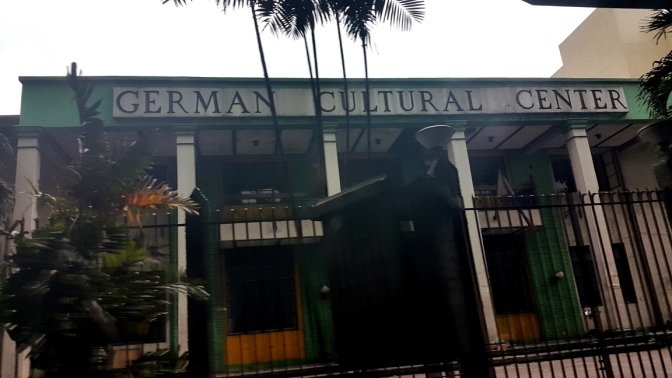
Doña Magdalena saw the cool atmosphere of this hilly former Jesuit land as an ideal residential area for the wealthy families of Manila, away from the over-crowded, dusty, and noisy streets of the city. When she started developing the Hacienda Hemady, both local and foreign families started buying up parcels of the land, and started building their mansions. Aside from the American colonialists, many other European and even West Asians purchased lots, and many of these were ambassadors to their respective counties. Some of these foreigners were German nations, which led to the transfer of the German cultural center, the Goethe-Institut (established 1961 in Pasay City), to a new property at the corner of Aurora Boulevard and Gilmore Avenue, in 1978. However, the growing traffic in the area and the construction of the of the overhead Light Rail Transit overshadowing the building would lead the Goethe-Institut’s relocation to the City of Makati, in 2006.
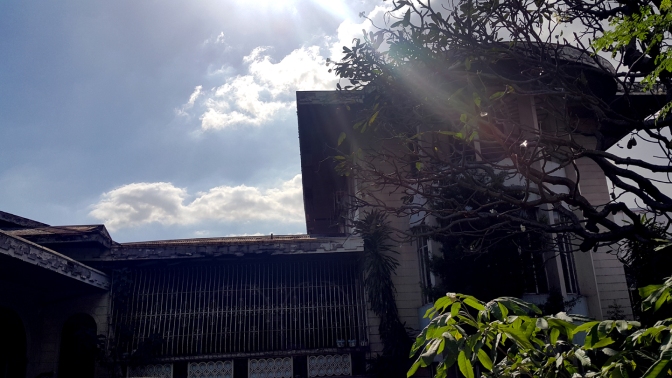
The central area of New Manila is under the jurisdiction of Barangay Mariana, which is believed to be named after Doña Magdalena’s daughter, Mariana Wilkinson. She lived along Balete Drive and was instrumental in organizing the barrio in the 1950s, until its establishment as a barangay in 1961. The nearby Victoria Street may have been named after Victoria Imperial Cortes, the daughter-in-law of Doña Magdalena and Juan Ysmael, who had married their son, Felipe.
For the Filipino residents, the most famous would be President Manuel Luis Molina Quezon (1878-1944), who moved into to #45 Gilmore Avenue, in 1927. The President was suffering from Tuberculosis, and needed the fresh clean air to help his recuperation. While residing in the Hacienda Hemady, President Quezon was investing in upgrading the nearby Santol Sanitarium (established 1918), of the Philippine Tuberculosis Society Inc. (established 1910). The new sanitarium was open and renamed the Quezon Institute in 1938, which included new buildings designed by the National Artist for Architecture, Juan Nakpil.
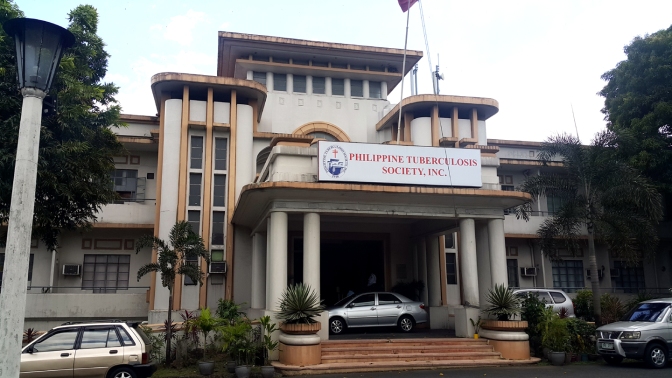
Arch. Juan Felipe Nakpil (1899-1986) was the son, of the musician and composer, Julio Garcia Nakpil (1867-1960) and Gregoria Álvarez de Jesús (1875-1943); who were known for their efforts during the Philippine Revolution (1896-1898). He initially took up engineering at the University of the Philippines, then he later studied architecture at the Fontainebleau School of Fine Arts, in France. After working for several architectural firms, Nakpil eventually opening his own architectural firm in 1930. Nakpil’s most noted works are San Carlos Seminary, Iglesia ni Cristo Riverside Locale (Now F. Manalo, San Juan), Capitol Theater, Captain Pepe Building, Manila Jockey Club, Rufino Building, Philippine Village Hotel, the Quezon Hall and Gonzales Halls of the U.P., and the Rizal Shrine in Calamba, Laguna. Nakpil was given the honor of National Artist for Architecture in 1973.

Although the Quezon home has been demolished, with its interior moved to a museum replica of the house in the Quezon Memorial Circle, one of the mansions that still stands and has sparked the curiosity of many passersby is the Villa Caridad, along Broadway Avenue. The eclectic Mediterranean styled house was built in the 1930s by Architect Domingo Lerma, for his relative, Dr. Jose Lerma, a Stanford graduate of dentistry and antique dealer/collector. Both the architect and dentist were from Tondo/Bicol clan of the zarzuela director, Florencio Lerma (1861-1897), who was martyred during the Katipunan Revolution of 1896-1898.
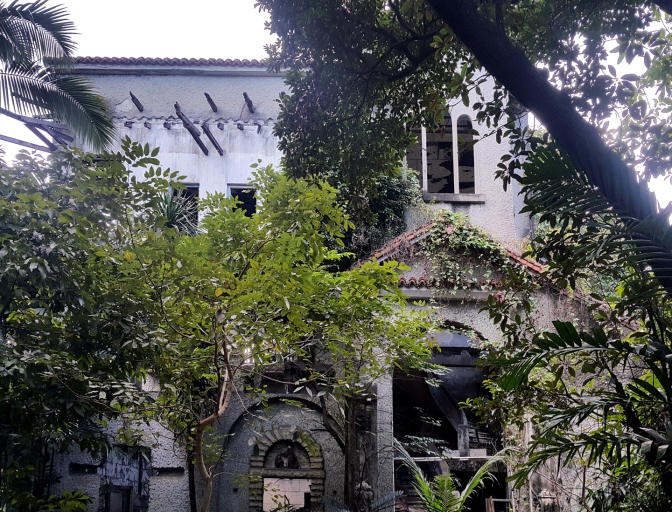
By the 1950s, Dr. Jose Lerma retired from his practice and moved to a smaller home in San Miguel, Manila, as living in such a large home was too cumbersome for an aging bachelor. The mansion was purchased by the Tondo/Nueva Ecija Ongsiaco-Gallego family, and was renovated by Arch. Alejandro Yelab Caudal (died around 1955), who was known to have designed many pre-war mansions in Manila and Bulacan. The new residents named the mansion Villa Caridad, after the matriarch Doña Caridad Valasco Ongsiaco-Gallego (1896-1974), who had established the Gallego Institute of Agriculture and Industry in the province of Nueva Ecija, in 1953, to help rehabilitate the post-war agricultural sector of Central Luzon. The Ongsiaco-Gallego used this mansion as their base in Manila, whereas they would spend much of their time in the hacienda in the province of Nueva Ecija, called Rancho Caridad. Both Doña Caridad and her husband, Don Manuel Viola Gallego (1893-1976), are buried in their Nueva Ecija estate.
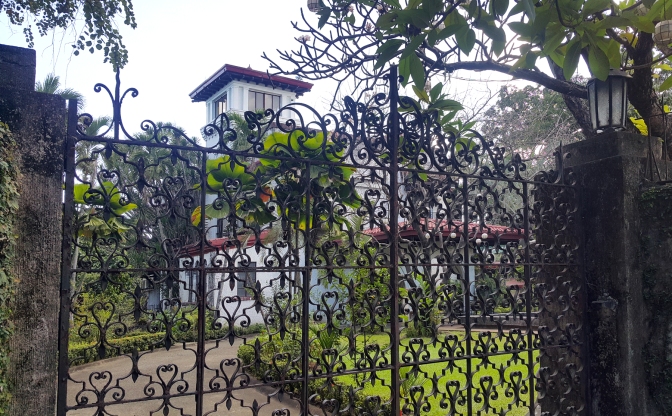
Another famous home along Broadway Avenue is the stately manor of Don José “Pepe” Roura Santiago de León (died 1934) and Doña Narcisa “Sisang” Buencamino-de León (1877-1966), one of the founding families of the LVN (De Leon, Villonco & Navoa) Studios, which was built in the nearby Cubao district. Don Pepe and Doña Sisang met in their hometown of San Miguel, Bulacan, where Don Pepe was the Capitan Municipal of the town and Sisang was a local seamstress. The couple engaged in the business of rice production, and later Doña Sisang was nominated as a director of the board of the National Rice and Corn Corporation, by President Quezon. During this time, the De León’s commissioned the National Artist for Architecture, Pablo Antonio, to design their home in the newly acquire property in Hacienda Hemady. Sadly, Don Pepe passed away one year before the house was completed in 1935. Shortly after her husband’s death, Doña Sisang was invited to invest in the fledgling film industry, and in 1940 she was elected as president of the company, where she would buy out the shares of her co-investors a lead the company until her death. Doña Sisang’s home in New Manila became a hub for the local show business people, and is still a popular filming location to this day.
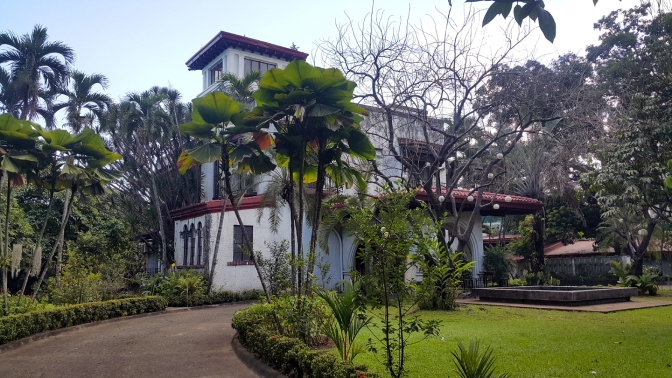
Arch. Pablo Sebero Antonio, Sr. (1901-1975) was a pioneer of modern Philippine architecture, moving from the Neoclassical aesthetics of the American Occupation (1898-1945) to the modernist Art Deco and International styles. Antonio first took a correspondence course in architecture and structural engineering, before enrolling at the Mapua Institute of Technology, but had to drop out due to the lack of funds. Fortunately, Antonio was sponsored by Eng. Ramon Arevalo, and he was able to complete his studies at the University of London. Upon returning to the Philippines and obtaining his license, Antonio’s talent was easily recognized and he was getting projects for institutions such as the Far Eastern University (FEU), Philippine National Bank, and Manila Railroad Company. Some of Antonio’s most noted works are the Nicanor Reyes Hall and Administration Building of the FEU, Manila Polo Club, the Galaxy Theater in Manila, and Ramon Roces Publications Building. At a latter point of his career, Antonio became president of the Philippine Institute of Architects (PIA). Antonio’s continuing thrust for a modern Philippine architectural landscape led to many awards and honors such as the Architect of the Year by PIA in 1952, the National Award of Merit for Architecture by the government, the Patnubay ng Sining at Kalinangan Award from the City of Manila in 1971, the Republic Cultural Heritage Award in 1972, and the National Artist in Architecture in 1976.
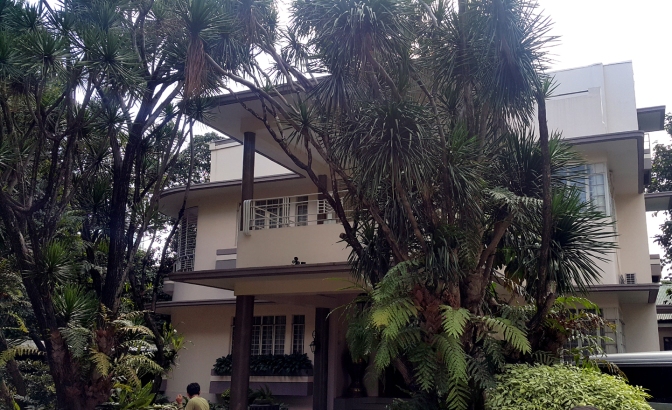
South of Gilmore Avenue is Valencia Street, which is the location of the Vera-Perez home and their famed Sampaguita Film Studios. The film studios was opened on site in 1937 by Judge Jose Olfinas Vera (1888-1956) and his wife, Doña Dolores Morato Honrado Vera (1896-1980); and they had their Art Deco styled home constructed within the studio compound in 1940. After Judge Vera retired, his daughter, Doña Azucena “Nene” Honrado Vera-Perez (1917-2014), took over the business with her husband, Dr. Jose Roxas Perez (1915-1975). With the closing of the studio in 1982, the old house would be the quite retirement home of Doña Nene, who requested her children to retain the home but repurpose it. So a few years after Doña Nene’s death, the studio and Vera-Perez home was reopened as the events place, Sampaguita Gardens.
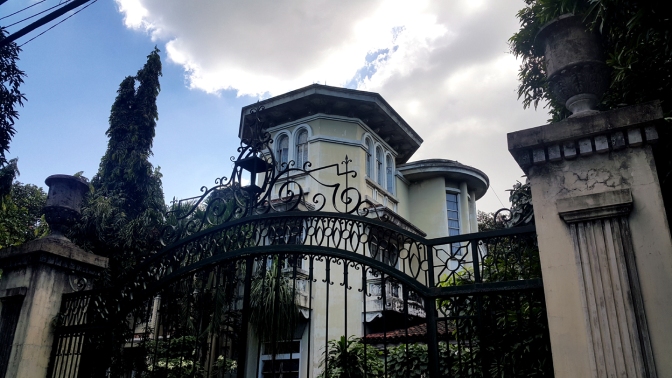
Broadway Avenue is the home of Dr. Potenciano Carpio Malvar (1867-1964) and Doña Eusebia Fule. Dr. Potenciano was born in Batangas, to Capitan Municipal “Imoy” Maximo Malvar (1844-1930) and Tiburcia Carpio (1845-1908). Dr. Potenciano is the younger brother of the famed revolutionary general, Miguel Malvar (1865-1911). Potenciano took his medical studies in Spain, and practiced in the Philippines, before being called to serve as a politician. Dr. Potenciano served as the governor of the Province of Laguna, representative of the municipality of San Perdo to the 2nd Philippine Legislature, and mayor of the municipality of San Pablo. The mansion along Broadway Avenue was built years after Dr. Potenciano’s retirement from politics.
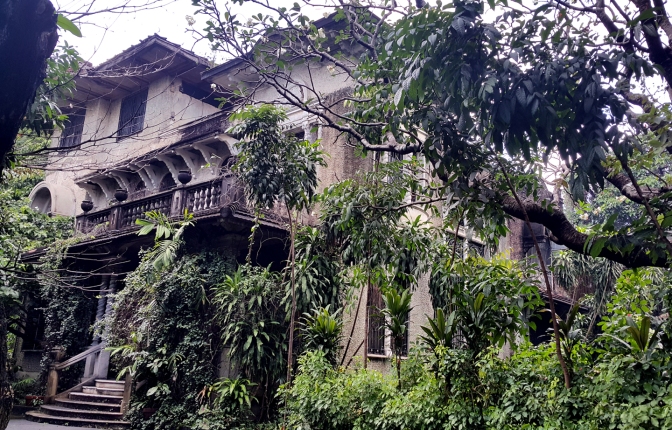
Another mansion on Broadway Avenue that is going through renovations is home of Dr. Félix Ochoa Cortés (1905-1968) and Doña Amparo Joven y de Keyser de Cortés (1911-2010), where Dr. Felix hailed from Manila, and Doña Amparo came from the town of Bacolor, Pampanga. Built in 1932, the house was a wedding gift of Dr. Felix to Doña Amparo, and was designed by a certain Arch. Enrique Santo Tomas. The house was taken over by Japanese forces during World War II, with one of the officers was a Kempetai intelligence officer, who had worked for the Cortés’ undercover as the family gardener. And during the Battle of Manila of 1945, the fleeing Japanese soldiers tried to destroy the house by leaving booby-trapped explosives in one of the cabinets, hoping to kill the American soldiers who were going house-to-house. Fortunately the nitroglycerin based bomb was neutralized, and the house was saved.
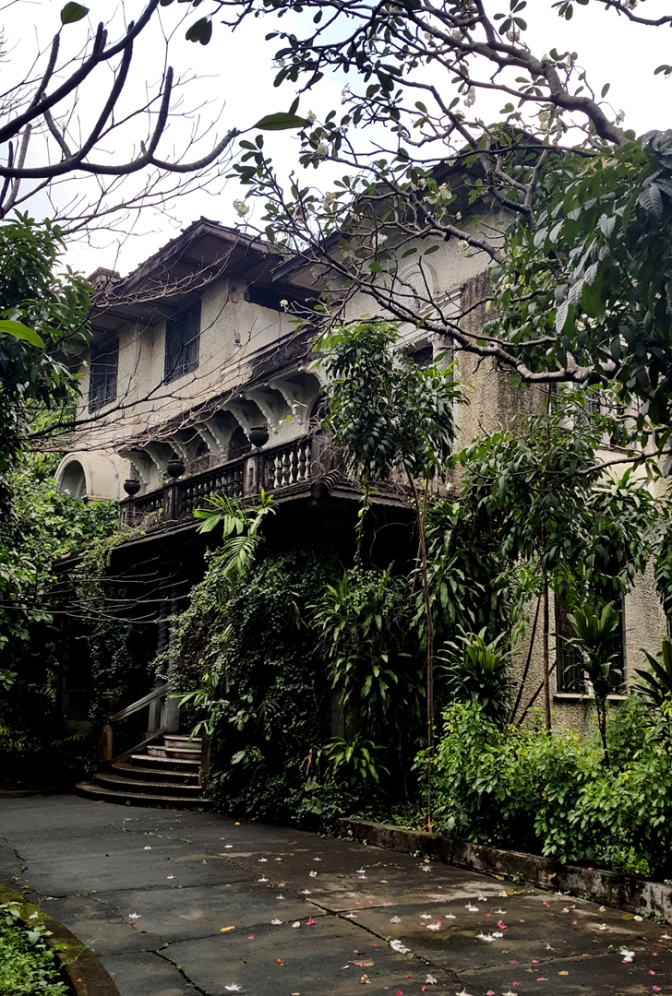
Dr. Cortes’ grandfather, Jose Doroteo Cortes y Yangco (1838-1919), was a lawyer and gobernadorcillo of Santa Cruz of the Santa Cruz district of Manila, who was famous for submitting the 1888 petition to Queen Maria Christina Henrietta Désirée Félicité Rénière (1858-1929) of Spain demanding the expulsion of all friars from the Philippines, and later worked for President Emilio Aguinaldo y Famy (1869-1964), during the Katipunan Revolution (1896-1898) against Spainish rule in the Philippines. On her paternal side, Doña Amparo came from a political family, in Bacolor, Pampanga; tracing her to roots to Don Juan Joven, a Chinese trader from Binondo who transferred to Bacolor, and eventually served as its gobernadorcillo. Don Juan’s political legacy was continued by the Pampanga Governor Ceferino Joven. On her maternal side, Doña Amparo’s maternal grandparents, Mariano Keyser and Leonora de Leon Keyser, were wealthy Spanish land owners from Bacolor. Doña Amparo’s family was part of the noted Kapampangan clans that united to establish the Pampanga Sugar Development Company (PASUDECO), in 1918. The PSUDECO Compound in San Fernando, Pamapanga, in now considered a heritage site.
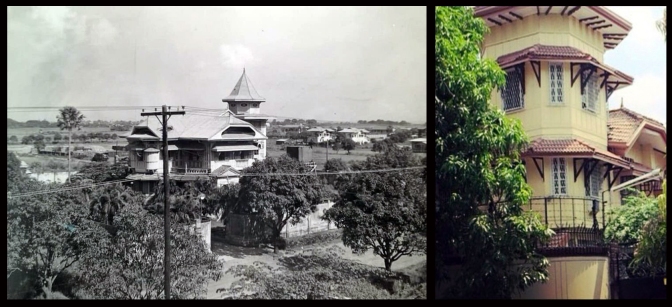
Right across the De Leon home on Broadway Avenue is where the founder of the Iglesia ni Cristo, Félix Manalo Ysagun (1886-1963). Manalo’s residence was at #42 Broadway, to be near the Iglesia’s Central Offices and temple at #5 Broadway, which was erected in 1925. With the Japanese invasion of World War II (1941-1945), Manalo moved his family and congregation to Santa Cruz, Manila; as the Japanese took over their properties. In 1950, Florencio de los Reyes Reyes (died 1967) and his wife, Salud Elchico Reyes, purchased the lot and built a new house to raise their family. The Don Florencio was a wealth landowner, with vast properties in Baguio City, Pampanga and Manila. Currently the lot is abandoned.
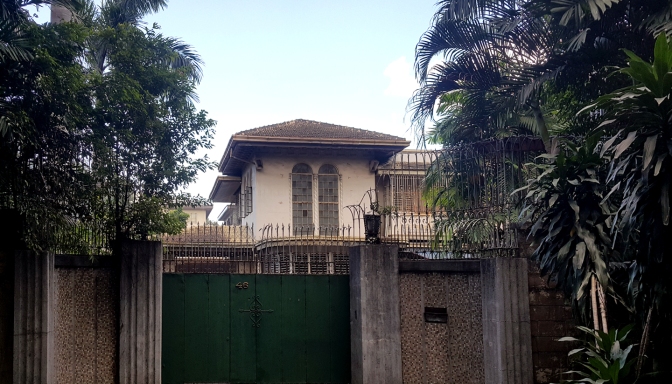
By the 1950s and 1960s, New Manila was jokingly called the “Quorum of the Senate” by its residents, with is many lawmakers living in the area. Among these notable residents were Senator Vicente María Epifanio Madrigal-López y Pardo de Tavera (1880-1972), Senate President Eulogio “Amang” Adona Rodríguez Sr. (1883-1964) and his wife Doña Juana Santiago Rodriguez, Senator Quintín Babila Paredes (1884-1973), Senator José Dira Avelino (1890-1986), Senator Benigno Simeon “Igno” Quiambao Aquino Sr. (1894-1947), Senator Geronima Josefa Tomelden Pecson (1895-1989), Senator Jose J. Roy (1904-1987), Senator Lorenzo Martinez Tañada Sr. (1898-1992), Senator Francisco “Soc” Aldana Rodrigo (1914-1998), senator and Vice-President Emmanuel Neri Pelaez (1915-2003), Senator Magnolia Rodriguez Welborn-Antonino (1915-2010), Senator Maria Villanueva Kalaw Katigbak (1912-1992), Senator Maria Paz Paterno Madrigal-Warns-Gonzales (1915-2008), Senator Alejandro Durano Almendras (1919-1995), who lived in #54 Gilmore Avenue, and senator and Vice-President Teofisto Tayko Guingona, Jr. (born 1928) .
Other notable politicians residing in the area were Chief Justice Ramón Avanceña (1872-1957), Ambassador Manuel Viola Gallego Sr. (1893-1976), Chief Justice José Y. Yulo (1894-1976), and Supreme Court Justice Cecilia Muñoz-Palma (1913-2006).

On Broadway Avenue is the home of Senator and Speaker of the Philippine National Assembly of the Japanese Occupation, Benigno Simeon “Igno” Quiambao Aquino Sr. (1894-1947). This was his home with his second wife, Doña Aurora Lampa Aquino (1910-1998), and one of their sons, the future senator, Benigno Simeon “Ninoy” Aquino Jr. (1932-1983), was the playmate of the eldest son of Dr. Jose and Doña Amparo Cortés. The most other children of Senator Igno & Maria Aurora “Maur” Aquino-Lichauco (born 1931), Senator Agapito “Butz” Aquino (1939-2015), Maria Gerarda “Ditas” Aquino (born 1935), and television and film director Maria Guadalupe “Lupita” Aquino- Kashiwahara (formerly Concio, born 1937), Senator Maria Teresa Aquino-Oreta (born 1944), and businessman Paul Aquino, until their selling the home years after the war. Senator Ingo’s political roots started with his father, Servillano Aquino y Aguilar (1874-1959), who was the mayor of Murcia, Tarlac, and served as a general during the Katipunan revelation against Spain (1896-1898) and Philippine-American War (1899-1902). Senator Ingo’s political aspirations extended to some of his children, whereas it was his daughter-in-law, Maria Corazon “Cory” Cojuangco Aquino (1933-2009), and grandson, Benigno Simeon “Noynoy” Cojuangco Aquino III (born 1960), who have achieved the highest position of President of the Philippines.
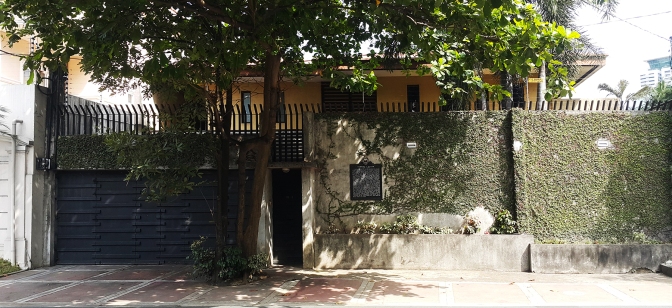
One discrete property along Broadway Avenue is the location where the educator, social worker, and politician, Geronima Josefa Tomelden Pecson (1895-1989) resided after World War II. Pecson is recognized as the first Filipina senator, who served from 1948 to 1954, and the first Filipino and woman to be elected to the executive board of the United Nations Educational, Scientific and Cultural Organization (UNESCO) in 1950. At the wall outside the compound, there is a historical marker that was installed by the National Historical Commission. Senator Geronima lived in this home with her husband, Judge Potenciano Pecson.

One of the highest ranking government officials to live in New Manila is former Vice-President Emmanuel Neri Peláez (1915-2003). In 1949, Peláez transferred to 11th Street in New Manila when he started his first term as the Congressional Representative (1949–1953) of the Municipality of Medina, in Misamis Oriental, Mindanao. Peláez had married the Capizeño Edith N. Fabella (1915-2014) in 1939, and the time he was serving as a congressman his family had already grown to include eight children, with the ninth on the way. So by leaving their Manila home for Quezon City, Emmanuel and Edith had a larger home to raise their family. This was their home, even when Peláez served as senator from 1953 to 1960, and as vice-president under the 1961-1965 term of President Diosdado Pangan Macapagal Sr. (1910-1997), and kept the home long after their children graduated from college and made their own families: Emmanuel Jr. (1941-2001), Ernesto (1943-2014), Elena (1947-2012), Esperanza (born 1948), Eloisa (born 1950), Eduardo (born 1950), Enrique (born 1951), Edmundo (born 1952), and Elvira (born 1954). The New Manila home would be the site for family gatherings and other social events, as Emmanuel and Edith enjoyed hosting, especially their grandchildren. However, the Peláez couple moved to gated community of Ayala Alabang in the 1984, to keep themselves secure in those turbulent times. From his new home, Emmanuel continued to serve in government, including working as the Philippine Ambassador to the United States from 1986 to 1992.
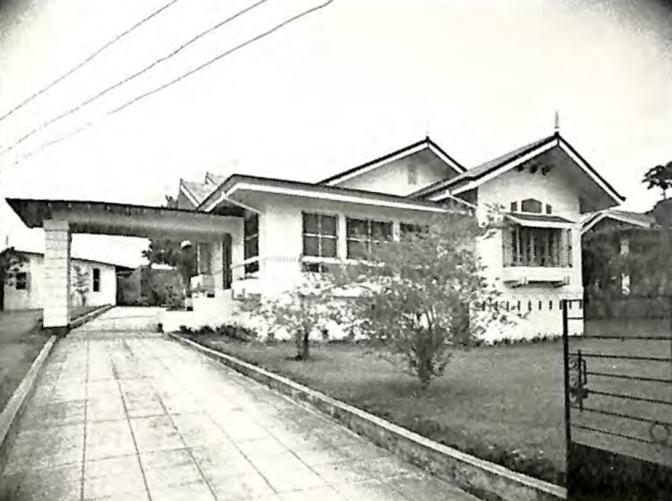
One of the homes that no longer stands is that of Ambassador Miguel Álvarez Pérez-Rubio (1925-2017), and his ex-wife Maria Luisa Cortes Ysmael Pérez-Rubio (1924-2011), granddaughter of Doña Magdalena. This mansion is a testimony of the resillence and fortitude of Pérez-Rubio, as Spanish-Filipino, who upon returning from Spain amidst the Spanish-Civil War, joins the Filipino guerrillas fighting the Japanese in World War II, at the age of 19. While fighting under the command of general and future president Manuel Acuña Roxas (1892-1948), Pérez-Rubio was captured and tortured in Baguio City. Upon his release and slow trek back to Manila, he discovers that his whole family was killed by the Japanese in their Vito Cruz home, on the 12th of Fenruary 1945. After the war, Pérez-Rubio was able to rebuilt his family’s finances and create a life of his own, serving under several presidents.
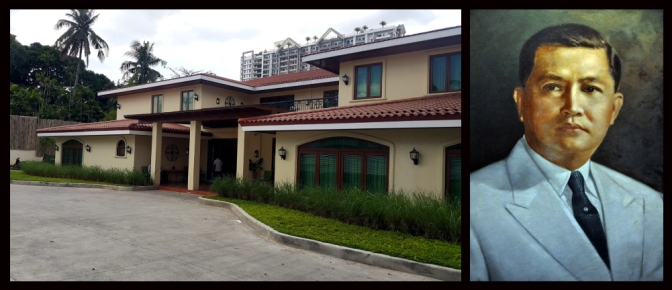
Another one of the old mansions that has been demolished is the home of Chief Justice José Y. Yulo (1894-1976). Judge Yulo came from Bago, Negros Occidental, and migrated to Manila to pursue his law studies in the University of the Philippines. As a corporate lawyer, Yulo was recognized for his skill and sharpness, as he was appointed as Justice Secretary by the American colonial Governor-General Frank Murphy, in 1934. He was later elected to the National Assembly of the Philippines, and served as the Chief Justice during the Japanese Occupation of the Philippines (1941-1945). He was called upon to serve again as Secretary of Justice from 1966 to 1967, before his retirement. After his death, Judge Yulo’s son, Jose Jr., engaged in real estate and developed the old mansion and other New Manila properties into modern homes. One of those new residences is the infamous Boracay Mansion along 11th Street, now called the Quezon City Reception House, which was a key part in the impeachment hearings against then President Joseph “Erap” Ejercito Estrada (born José Ejército y Marcelo; born 1937).
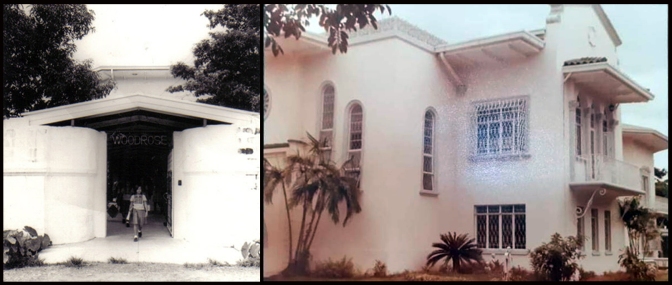
At the corner of Gilmore and 4th street was the home of Fernando Pantangco Jacinto, Sr., the father of the Philippine steel industry, who had founded the Iligan Integrated Steel Mills, Inc. (IISMI) and Jacinto Steel, Inc. (JSI). He was the son of Dr. Nicanor Santos Jacinto Sr. (1886-1971), a founding member of the International College of Surgeons-Philippine Section and Bank of Commerce and Security Bank; as well as head of the Doctor’s Hospital and chief of surgical service at the University of Santo Tomas Hospital. Jacinto abandoned the mansion and migrated to America, after his businesses were sequestered by the government in 1974, after he criticized the presidency of Ferdinand Emmanuel Edralin Marcos Sr. (1917-1989). In 1976, the house was sold to the PAREF Woodrose School, which operated its elementary school from 1977 to 1981, then transferred to Alabang, Muntinlupa City. The house was then purchased by the Missionarii Sacratissimi Cordis (Missionaries of the Sacred Heart, MSC, est. in the Philippines in 1908), who had transformed the house into their Provincialate in 1983. After the old home was razed by a fire in 1988, and a new MSC Central House was constructed in its place, and still stands to this day.

Along Balete Drive was the home of Senator Vicente María Epifanio Madrigal-López y Pardo de Tavera (1880-1972), a Spanish Filipino who hailed from Ligao, Albay. After his stint in politics during the 1940s, Senator Vicente would return to the business of real estate, which his wife, Susana Paterno y Ramos, had urged him into, before her death in 1941. Many of Senator Vicente’s real estate investments went to developing the gated residential subdivisions for the rich; such as the Corinthian Gardens in Quezon City, the Arcadia Village in Pasig, and the Ayala Alabang in Muntinlupa City. Senator Vicente also partnered with Doña Narcisa Buencamino-de León as one of the major stockholders of the Rizal Cement Corporation. He also had businesses in shipping, agriculture, and exports. After Senator Vicente’s death; the old house was converted to a row of modern town houses.

Another famous Post-War mansion that have been replaced with a modernist home is that of Doña Josephine Beley Murphy de Cojuangco (1896-2008) that once took most of the block between Balete drive, Bouganvilla and Hibiscus streets. Doña Josephine was born to the Irish-American John James Murphy and the Ilocana, Gregoria Beley; owners of the Alhambra Theater, in Baguio City. She married Eduardo Cojuangco y Chichioco Sr. (1902-1952), from Paniqui, Tarlac, and they resided in Santa Ana, Manila. After the war, the Cojuangcos were able to purchase the New Manila property from an American who wanted to return to the USA, after being interred at the Japanese prison camp in the University of Santo Tomas campus, during the war. The new house was a continuous work-in-progress, but Doña Josephine was forced to foresee the completion of the home, after the death of Don Eduardo, in 1952. Presently, part of the lot has been converted to residential business establishments, while the site of the old house is now a modern mansion where her son, the businessman and politician, Eduardo “Danding” Cojuangco, Jr. (1935-2020), had resided.

On the northern end of New Manila is the home of Arch. Arturo M. Mañalac (1915-1990), along Sunnyside Drive. Arch. Mañalac is known for designing churches; such as the 1941 Baroque Sacred Heart of Jesus Parish in the Kamuning area, the 1950 Neo-Romanesque Immaculate Conception Parish in Cubao, and the Augustinian Recollect’s Neo-Gothic 1952 Convento de San Sebastian in Sampaloc, 1953 Casiciaco Recoletos Seminary in Baguio, the Immaculate Conception Cathedral Parish in Puerto Princesa City, the 1950 Monasterio de Santa Clara and 1957 Santa Rita de Cascia Parish in Quezon City, and the 1953 Santuario De San Antonio Parish in Makati City. Arch. Mañalac completed his family home in 1956, and would have it sold to the Congregation of The Blessed Sacrament (Societas Sanctissimi Sacramenti or SSS for short), two years after his death.

Another old home on Balete Drive was that of Maria Clara “Nena” Recto and Tomas “Tomasing” Topacio Garchitorena (1907-1966) of Tigaon, Partida, Camarines Sur. Nena Recto was the daughter of the first wife of Senator Claro Mayo Recto (1890-1960). Nena married Tomasing, and had two daughters: Maria Lourdes and Maria Elena. Lourdes died at the age of 2, whereas Elena died in a car accident, in 1949. Neighbors began to spread rumors about Elena’s death, and it linked to urban legend of “white lady” ghost who appears inside the rear seats of automobiles passing through Balete Drive. Although the stories were just creations of the idles mind, the death of their daughters proved too difficult for the couple and they divorced, and years later, Nena would marry the American WW2 veteran, John Arthur “Jack” Warner (1915-1972), and migrate to Spain. Nena and Jack had two children, Penelope Anne “Penny” Recto Warner (married a Count De Salamanca) and John “Jack” Arthur Warner, Jr., who are believed to be still alive as of the writing of this article.

Along Broadway Avenue, Vicente Antonio Heras (1894-1978) built his home with his wife Celine Lacson-Heras, heiress to the power Lacson clan of Negros. Heras was able to build a transport empire by importing of German buses to establish the JD Transit and Taxi Co., the MD Transit & Taxi Co., the CAM Transit, and the De Dios Transportation Co. In 1948, Heras opened a Mobilgas Station at the corner of N. Domingo and Broadway Ave, as the first gas station in New Manila. In 1972, Heras expanded his business to shipping, with the founding of the Navegante Shipping Agency LTD, in Hong Kong.
There are many more ancestral houses in New Manila, whose histories are clouded from public knowledge, at this time of writing. There are also some ancestral homes hidden behind the high walls that passersby would not be aware of. And there are also mansions in plain site that no one seems to be talking about, including their caretakers.
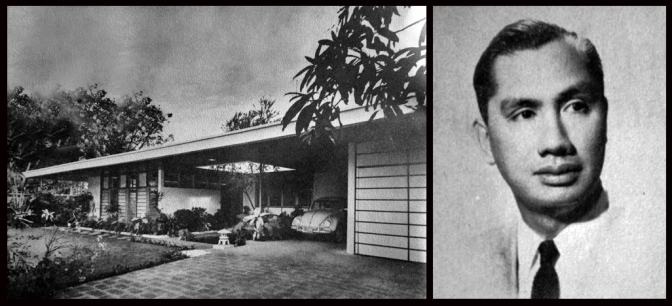
Never-the-less, there are many more residents whose stories about their homes in New Manila have yet to be told. Among these noted New Manila residents are Manuel Alcuaz y Tuazon (1897-1970) and Rosa Araneta y Zaragoza (born 1906), who purchased a house built in 1927 from the Italian-American, Louis Joseph Francisco in 1941; and the family of Don José Amado Araneta (1907-1985), who would eventually develop the nearby commercial district of Cubao, in the 1950s.
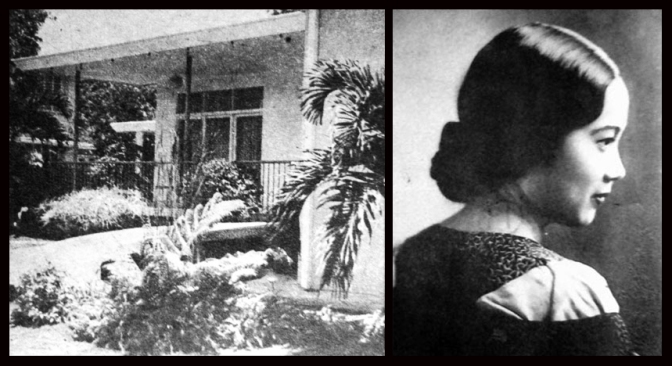
There were also the pre-war homes that were converted into modernist mansions, such as those of gastroenterologist Dr. Jesus and Ambassador Rafaelita Hilario-Soriano (1915-2007) and Architect Carlos D. Corcuer-Arguelles (1917-2008).
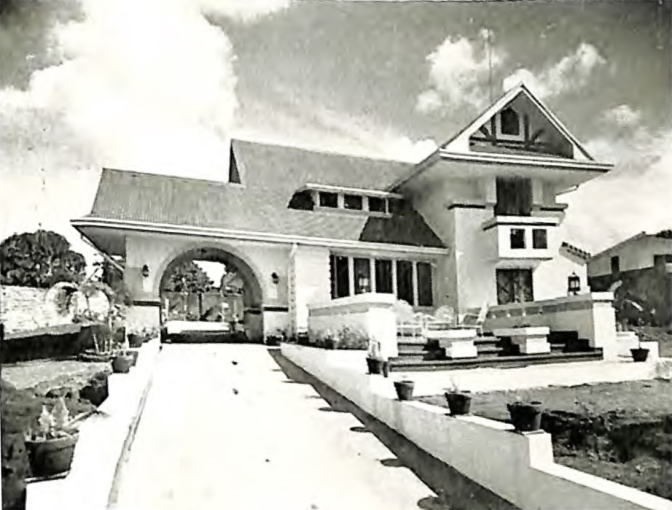
And finally, there is the home of Major Gen. Benedicto “Benjamin” Sy Valenzona Sr. from Cebu, who served in the President Quezon’s Own Guerrillas (PQOG) in World War II. Valenzona was part of the propaganda group of the PQOG’s Tafalla Unit, II Corps Area, printing the underground newspaper The Liberator (40 to 60 issues), starting in July 1944. Valenzona was also part of the raid of the Los Baños concentration camp on the 23rd of February 1945. Aside from propaganda, Valenzona was responsible for the printing and authentication of the guerilla money used by the PQOG, and helped Col. Fernándo Pérez Canon organized the LECARPE counter-intelligent group. In his later years, Valenzona would represent Pres. Carlos Polestico Garcia (1896-1971), in the Philippine government’s claim of the Sabah province as the property of the then Sultan of Sulu, Mohammed Esmail Kiram (died 1974), and part of the Philippine national territory.
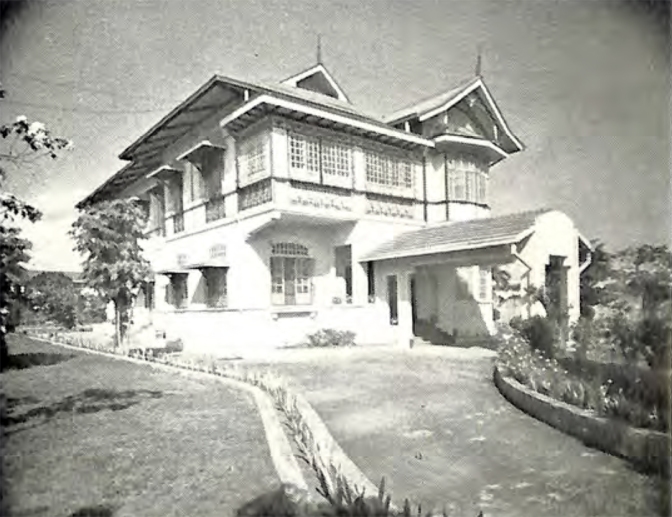
And for those old residents, the post-war center of the community would become the Shrine Our Lady of Mount Carmel Parish, which is the subject of my next article.
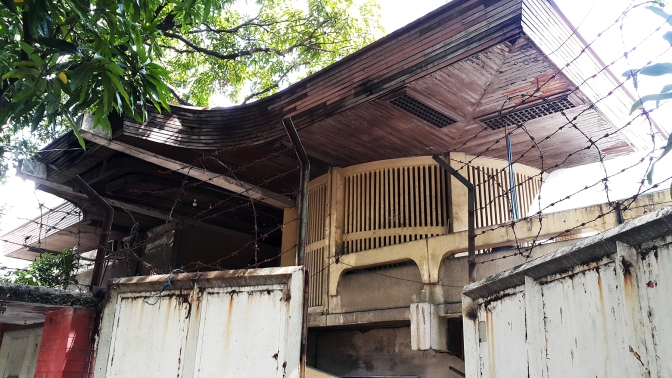
























Hello,
I’m a direct descendant of P. E. Domingo whose house was remembered by my mother to be beside Doña Sisa’s (LVN). That side of our family is currently not in good condition and can’t, therefore, tell me the history or even provide photos. My mother and her siblings were not welcomed by the envious siblings of their mom, my grandmother, so they were only allowed a few luxuries there. I hope you can investigate and give us a glimpse of what it is now.
LikeLike
My Maternal French Emigre Great Grandfather Jose Desire Firon Fournier passed away young at 59 He worked for Manila Railroad in his will he bequeathed a piece of property next to P.E. Domingo as the story goes , my Lolo was the last to sell his share and all his siblings to his sister who didnt have children, She was married to a famous Dr. From Baguio. Both passed away and we don’t know what happened to that property.
LikeLike
The Boracay Mansion was the house of Belek and Vicky Madrigal
Ambassador Antonio Delgado house in Victoria St
LikeLike